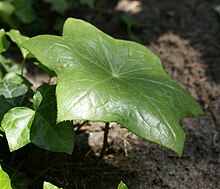| Podophyllum pleianthum | |
|---|---|

| |
| Leaves can be up to 45 cm (18 in) wide | |
| Scientific classification | |
| Kingdom: | Plantae |
| Clade: | Tracheophytes |
| Clade: | Angiosperms |
| Clade: | Eudicots |
| Order: | Ranunculales |
| Family: | Berberidaceae |
| Genus: | Podophyllum |
| Species: | P. pleianthum |
| Binomial name | |
| Podophyllum pleianthum Hance | |
| Synonyms | |
List
| |
Podophyllum pleianthum (syn. Dysosma pleiantha), the many-flowered Chinese mayapple, is a species of flowering plant in the genus Podophyllum, native to south-central and southeast China, including Taiwan. Shade tolerant, and deer resistant due to its toxicity, it has gained the Royal Horticultural Society's Award of Garden Merit.
Pharmacology
Podophyllum pleianthum or Bajiaolian has been use in traditional Chinese medicine in China and Taiwan for the treatment of snake bite, weakness, condyloma accuminata, lymphadenopathy and tumors through ingestion of dried roots and rhizomes or application of resin.
Podophyllotoxin is a major active ingredient in Podophyllum pleianthum that is cytotoxic, arresting cellular metaphase and microtubule formation in cells. Symptoms of intoxication include nausea, vomiting, diarrhea, abdominal cramps, tachycardia, orthostatic hypotension, paralytic ileus, urinary retention, hepatorenal dysfunction, leukocytosis followed by leukopenia, thrombocytopenia, prolonged areflexia, prolonged paraethesia and sensory ataxia, dizziness, fever, memory impairment, hallucinations, paranoia, convulsion, fainting, and coma.
References
- J. Bot. 21: 175 (1883)
- ^ "Podophyllum pleianthum Hance". Plants of the World Online. Board of Trustees of the Royal Botanic Gardens, Kew. 2017. Retrieved 17 November 2020.
- "Podophyllum pleianthum many-flowered Chinese mayapple". The Royal Horticultural Society. Retrieved 17 November 2020.
- ^ Kao, Wei-Fong; Hung, Dong-Zong; Tsai, Wei-Jen; Lin, Kon-Ping; Deng, Jou-Fang (1992). "Podophyllotoxin Intoxication: Toxic Effect of Bajiaolian in Herbal Therapeutics". Human & Experimental Toxicology. 11 (6). SAGE Publications: 480–487. doi:10.1177/096032719201100607. ISSN 0960-3271.
- Chu, Chun-Che; Huang, Chin-Chang; Chu, Nai-Shin (2000). "Sensory Neuropathy due to Bajiaolian (Podophyllotoxin) Intoxication". European Neurology. 44 (2). S. Karger AG: 121–123. doi:10.1159/000008210. ISSN 0014-3022.
- Chou, Shang-Lin; Chou, Ming-Yueh; Kao, Wei-Fong; Yen, David H.T.; Huang, Chun-I; Lee, Chen-Hsen (2008). "Cessation of nail growth following Bajiaolian intoxication". Clinical Toxicology. 46 (2). Informa UK Limited: 159–163. doi:10.1080/15563650701397159. ISSN 1556-3650.
External links
- [REDACTED] Media related to Podophyllum pleianthum at Wikimedia Commons
- [REDACTED] Data related to Podophyllum pleianthum at Wikispecies
| Taxon identifiers | |
|---|---|
| Podophyllum pleianthum | |
| Dysosma pleiantha | |
This Berberidaceae article is a stub. You can help Misplaced Pages by expanding it. |